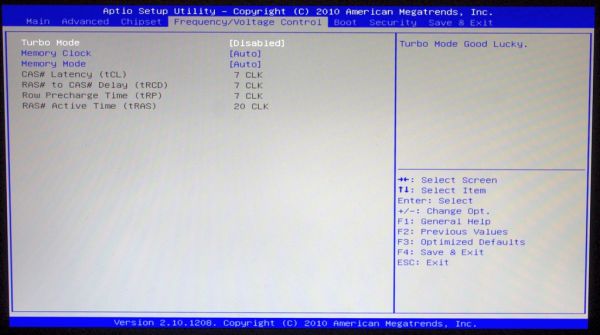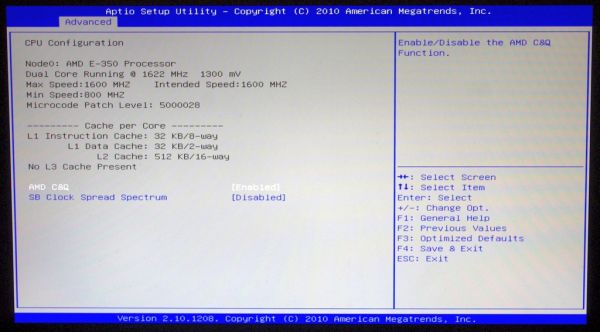Fusion E-350 Review: ASUS E35M1-I Deluxe, ECS HDC-I and Zotac FUSION350-A-E
by Ian Cutress on July 14, 2011 11:00 AM ESTECS BIOS' of past have been rather lacking, in terms of options and design. Sadly, the HDC-I is no exception to this rather flat rule. The take on it seems to be 'it works, so much for the user experience'. Options are, for the most part, spread out across menus rather than being consolidated, and there's no serious information connection. Take the main page - there's no mention of the motherboard type, the CPU model currently in it, the speed of the processor, the amount of memory or the temperature. This information is on other screens, but it's nice to have it on the first screen at least.
By default the SATA ports are set to IDE rather than AHCI, but the money shot of the BIOS is in the 'Frequency/Voltage Control' Menu. The first option here is the 'Turbo Mode', with the help message of 'Turbo Mode Good Lucky'.
What this option does is impressive. Change it to the enabled setting, and the board will apply a 33% overclock to the processor, and automatically adjust the voltage. With this option as standard, they've decided against adding any other overclock options (like the ASUS board) apart from the memory, where DDR3-800 to DDR3-1333 are selectable (which equates to DDR3-1064 to DDR3-1777 when overclocked), as well as the major subtimings. By default, DDR3-800 and 7-7-7-18 were selected when left on auto on our Patriot Viper Xtreme set.
The other positive feature of the BIOS is the boot override - something every BIOS should have by now. If you want a one-time boot from a separate device (CD, DVD, USB) then this is the option to do it. It thankfully accepts NTFS file systems (unlike some ASRock boards) as well.
Overclocking
In terms of overclocking, there's not much to say, apart from the turbo mode available in the BIOS, adding 33% clock speed to 2.13 GHz. The default bus speed flickers between 100 MHz and 102.1 MHz, so at overclock it flickers between 133 MHz and 135.1 MHz, giving a little advantage over other boards. This 33% boost also affects the memory, turning the DDR3-1333 setting into DDR3-1772, which is also a large improvement. There are no overclocking options for the OS though.
The overclock gave a boost of 34.5% boost to our single threaded 3D Movement benchmark, and a 33.0% boost to the multithreaded version. In terms of power, during video, the overclocked version consumed 5W more as a peak value, though this difference was not seen in Metro2033 or OCCT.



















67 Comments
View All Comments
andymcca - Friday, July 15, 2011 - link
My bad, missed this on page 11 during my first read-through.tvarad - Friday, July 15, 2011 - link
Ian,I understand your compulsions, but it's like taking a Smart, testing it like a Ferrari and then critiquing it. That's not quite what AMD had in mind on how it intended the board to be used (I own Intel stock, so this is not about taking sides). I have the Asus board and I am using it with a tiny brick that puts out about 47W and powers a Pico-psu 120W 12V-25V wide input range power supply. It's function is as a HTPC/Video Server, hence I have just a 2TB WD HD attached to it, with an external removable media drive. With 2GB Gskill Eco Ram and a 140MM fan, it never goes above 40W when booting up and idles at around 22-23W. With 1080P mkv content play, the consumption goes upto about 30W. I don't plan to overclock it. I'll go out on a limb and say that my rig is more representative of how the board will be used in the real world.
BTW, the square thingies on the pico-psu (at least the model I'm using) jut out onto the second dimm slot rendering it useless. Something you may want to watch out for.
triclops41 - Thursday, July 14, 2011 - link
Easy there, Finally,There are things to criticize about this review on benchmarks chosen or other technical details, but I have not seen any pro atom or anti brazos bias by Ian, or anyone else at Anandtech. Maybe some bias towards synthetic benchmarks, that Intel often wins, but that has more to do with the constraints of hardware reviews, not allegiance to some producer.
Finally - Tuesday, July 26, 2011 - link
Well said. I still really wonder, why there are so many encoding benchmarks here. After all - how many people actually do encode videos? I've never done so my whole life and don't intend starting to. The funny thing is that these are usually the benchmarks where the press is deriving their ridiculous high speed advantages of new Intel CPUs from...If someone came along and said that this "advantage" is completely lost on them, those CPUs wouldn't be that great, because real world game fps are almost always very close to each other...
corporategoon - Thursday, July 14, 2011 - link
I don't really have any comments on the benchmarks or thoroughness or balance of this article (seems fine to me) but this is one of the most poorly-written articles I've ever seen on AnandTech. Anand has a serious problem with sentence fragments but most articles that appear on the site are reasonably well-written. The opening paragraph is borderline unreadable.new-paradigm - Thursday, July 14, 2011 - link
Ok, I may be being dense, but I cant seem to find if any of these boards offer video and sound through the HDMI port?jrs77 - Thursday, July 14, 2011 - link
I've got two miniITX Atom boards. A Zotac IONITX A-E and an ASUS AT3IONT-I Deluxe (both sporting an onboard PSU with a 90Watt powerbrick !!!). Both of them do work like a charm and I'm even capable of playing MMOs (EvE Online) on them in low settings. They draw some 35 Watt from the plug in the wall under load.So why there's no comparison to the Atom-ION boards as they're the direct competition and on the market for a few years now allready?
stmok - Friday, July 15, 2011 - link
While the overall article is OK, it just doesn't have that usefulness of your typical Anandtech article in some areas that make it stand out.For example:
Why did you not include the ECS solution alongside the ASUS one for the overclock part on page 15?
=> http://www.anandtech.com/show/4499/fusion-e350-rev...
What about assessing noise?
=> Sure, you have the two passive mobos, but how loud/quiet was that fan cooled one?
futurepastnow - Friday, July 15, 2011 - link
Looks like the big heatsink ASUS uses is mostly for show since the much smaller one on the Zotac board puts it to shame.beginner99 - Friday, July 15, 2011 - link
... of bobcat. In the forums you can read it having trouble with 1080p sometimes especially flash. Not ideal for a htpc. The GPU part is mostly useless for a HTPC or NAS. Also these mini-ITX boards are pretty expensive and mini-ITX + core i3 doesn't cost much more and would also not use much more power in idle/normal usage but better max. performance for like flash (HTPC) or Software RAID 5 (NAS).Especially for a NAS the price difference is minimal because any small case with lots of HDD bays is pretty expensive.